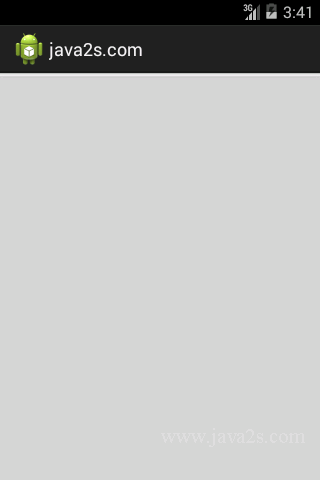Handle custom Gesture
Description
The following code shows how to Handle custom Gesture.
Code revised from
Android Recipes:A Problem-Solution Approach
http://www.apress.com/9781430234135
ISBN13: 978-1-4302-3413-5
Example
package com.java2s.myapplication3.app;
/*from w ww. j a va 2 s . c om*/
import android.content.Context;
import android.util.AttributeSet;
import android.view.GestureDetector;
import android.view.GestureDetector.SimpleOnGestureListener;
import android.view.MotionEvent;
import android.view.View;
import android.view.ViewConfiguration;
import android.widget.FrameLayout;
import android.widget.Scroller;
import android.app.Activity;
import android.os.Bundle;
import android.widget.ImageButton;
import android.widget.ImageView;
import android.widget.LinearLayout;
public class MainActivity extends Activity {
@Override
protected void onCreate(Bundle savedInstanceState) {
super.onCreate(savedInstanceState);
PanGestureScrollView scrollView = new PanGestureScrollView(this);
LinearLayout layout = new LinearLayout(this);
layout.setOrientation(LinearLayout.VERTICAL);
for(int i=0; i < 5; i++) {
ImageView iv = new ImageButton(this);
iv.setImageResource(R.drawable.ic_launcher);
layout.addView(iv, new LinearLayout.LayoutParams(1000, 500));
}
scrollView.addView(layout);
setContentView(scrollView);
}
}
class PanGestureScrollView extends FrameLayout {
private GestureDetector mDetector;
private Scroller mScroller;
/* Positions of the last motion event */
private float mInitialX, mInitialY;
/* Drag threshold */
private int mTouchSlop;
public PanGestureScrollView(Context context) {
super(context);
init(context);
}
public PanGestureScrollView(Context context, AttributeSet attrs) {
super(context, attrs);
init(context);
}
public PanGestureScrollView(Context context, AttributeSet attrs,
int defStyle) {
super(context, attrs, defStyle);
init(context);
}
private void init(Context context) {
mDetector = new GestureDetector(context, mListener);
mScroller = new Scroller(context);
// Get system constants for touch thresholds
mTouchSlop = ViewConfiguration.get(context).getScaledTouchSlop();
}
/*
* Override the measureChild... implementations to guarantee that the child
* view gets measured to be as large as it wants to be. The default
* implementation will force some children to be only as large as this view.
*/
@Override
protected void measureChild(View child, int parentWidthMeasureSpec,
int parentHeightMeasureSpec) {
int childWidthMeasureSpec;
int childHeightMeasureSpec;
childWidthMeasureSpec = MeasureSpec.makeMeasureSpec(0,
MeasureSpec.UNSPECIFIED);
childHeightMeasureSpec = MeasureSpec.makeMeasureSpec(0,
MeasureSpec.UNSPECIFIED);
child.measure(childWidthMeasureSpec, childHeightMeasureSpec);
}
@Override
protected void measureChildWithMargins(View child,
int parentWidthMeasureSpec, int widthUsed,
int parentHeightMeasureSpec, int heightUsed) {
final MarginLayoutParams lp = (MarginLayoutParams) child
.getLayoutParams();
final int childWidthMeasureSpec = MeasureSpec.makeMeasureSpec(
lp.leftMargin + lp.rightMargin, MeasureSpec.UNSPECIFIED);
final int childHeightMeasureSpec = MeasureSpec.makeMeasureSpec(
lp.topMargin + lp.bottomMargin, MeasureSpec.UNSPECIFIED);
child.measure(childWidthMeasureSpec, childHeightMeasureSpec);
}
// Listener to handle all the touch events
private SimpleOnGestureListener mListener = new SimpleOnGestureListener() {
public boolean onDown(MotionEvent e) {
// Cancel any current fling
if (!mScroller.isFinished()) {
mScroller.abortAnimation();
}
return true;
}
public boolean onFling(MotionEvent e1, MotionEvent e2, float velocityX,
float velocityY) {
// Call a helper method to start the scroller animation
fling((int) -velocityX / 3, (int) -velocityY / 3);
return true;
}
public boolean onScroll(MotionEvent e1, MotionEvent e2,
float distanceX, float distanceY) {
// Any view can be scrolled by simply calling its scrollBy() method
scrollBy((int) distanceX, (int) distanceY);
return true;
}
};
@Override
public void computeScroll() {
if (mScroller.computeScrollOffset()) {
// This is called at drawing time by ViewGroup. We use
// this method to keep the fling animation going through
// to completion.
int oldX = getScrollX();
int oldY = getScrollY();
int x = mScroller.getCurrX();
int y = mScroller.getCurrY();
if (getChildCount() > 0) {
View child = getChildAt(0);
x = clamp(x, getWidth() - getPaddingRight() - getPaddingLeft(),
child.getWidth());
y = clamp(y,
getHeight() - getPaddingBottom() - getPaddingTop(),
child.getHeight());
if (x != oldX || y != oldY) {
scrollTo(x, y);
}
}
// Keep on drawing until the animation has finished.
postInvalidate();
}
}
// Override scrollTo to do bounds checks on any scrolling request
@Override
public void scrollTo(int x, int y) {
// we rely on the fact the View.scrollBy calls scrollTo.
if (getChildCount() > 0) {
View child = getChildAt(0);
x = clamp(x, getWidth() - getPaddingRight() - getPaddingLeft(),
child.getWidth());
y = clamp(y, getHeight() - getPaddingBottom() - getPaddingTop(),
child.getHeight());
if (x != getScrollX() || y != getScrollY()) {
super.scrollTo(x, y);
}
}
}
/*
* Monitor touch events passed down to the children and intercept as soon as
* it is determined we are dragging
*/
@Override
public boolean onInterceptTouchEvent(MotionEvent event) {
switch (event.getAction()) {
case MotionEvent.ACTION_DOWN:
mInitialX = event.getX();
mInitialY = event.getY();
// Feed the down event to the detector so it has
// context when/if dragging begins
mDetector.onTouchEvent(event);
break;
case MotionEvent.ACTION_MOVE:
final float x = event.getX();
final float y = event.getY();
final int yDiff = (int) Math.abs(y - mInitialY);
final int xDiff = (int) Math.abs(x - mInitialX);
// Verify that either difference is enough to be a drag
if (yDiff > mTouchSlop || xDiff > mTouchSlop) {
// Start capturing events
return true;
}
break;
}
return super.onInterceptTouchEvent(event);
}
/*
* Feed all touch events we receive to the detector for processing.
*/
@Override
public boolean onTouchEvent(MotionEvent event) {
return mDetector.onTouchEvent(event);
}
/*
* Utility method to initialize the Scroller and start redrawing
*/
public void fling(int velocityX, int velocityY) {
if (getChildCount() > 0) {
int height = getHeight() - getPaddingBottom() - getPaddingTop();
int width = getWidth() - getPaddingLeft() - getPaddingRight();
int bottom = getChildAt(0).getHeight();
int right = getChildAt(0).getWidth();
mScroller.fling(getScrollX(), getScrollY(), velocityX, velocityY,
0, Math.max(0, right - width), 0,
Math.max(0, bottom - height));
invalidate();
}
}
/*
* Utility method to assist in doing bounds checking
*/
private int clamp(int n, int my, int child) {
if (my >= child || n < 0) {
/*
* my >= child is this case: |--------------- me ---------------|
* |------ child ------| or |--------------- me ---------------|
* |------ child ------| or |--------------- me ---------------|
* |------ child ------|
*
* n < 0 is this case: |------ me ------| |-------- child --------|
* |-- mScrollX --|
*/
return 0;
}
if ((my + n) > child) {
/*
* this case: |------ me ------| |------ child ------| |-- mScrollX
* --|
*/
return child - my;
}
return n;
}
}
